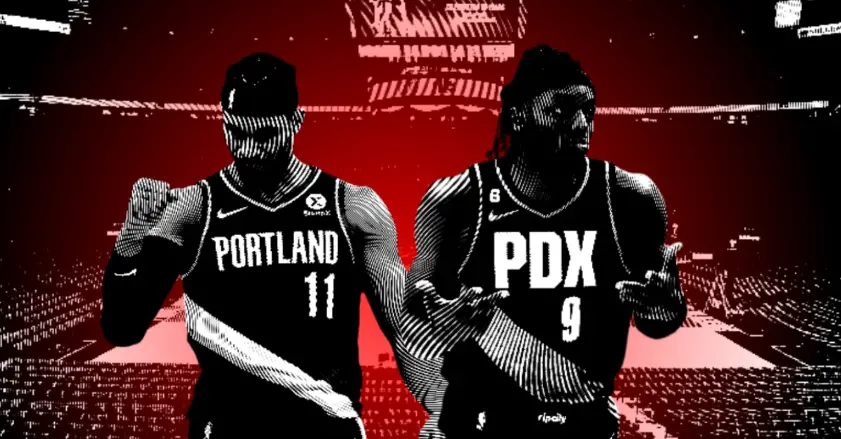Here’s something strange: Portland’s defense is way better than last year despite giving up almost the same shot distribution to opponents: loads of threes and layups.
As I detailed here, Portland had a nightmare season last year and ended with the second-worst defense in the league. First-time head coach Chauncey Billups (aided by defensive-minded assistant coach Roy Rogers) implemented an aggressive hedging defense that didn’t mesh particularly well with his team. He was displeased with many players’ efforts; they, in turn, didn’t like the scheme, and it became surprisingly public. Billups eventually scrapped everything and tried many changes to create a coherent defense around his limited personnel. It never happened.
This year, with better athletes available, Billups and Rogers took last year’s chaos and refined it into one of the most schematically flexible units in the league. They change defenses like a chameleon changes colors, adapting to best meet their surroundings.
According to Synergy Sports, they run zone 14% of the time, more than any team (including the Blazers) ran last year and second only to Miami this year. In addition, they constantly change pick-and-roll coverages and haven’t hesitated to put players in unorthodox positions to succeed. For example, Jerami Grant, a power forward by nature, has spent much of his time guarding the other team’s point guards with significant success. His 7’3” wingspan is an endless hug that smaller players cannot escape.
But the weird thing is that, despite significant personnel and schematic changes, the team is giving up the same shots as last season; teams are just missing more often. From Cleaning the Glass (the colored numbers are league ranks), here is the distribution of opponent shot locations.
How to read: for example, in ’22-’23, 37.9% of opponents’ shots are coming at the rim, which is the 28th-best mark in the league. These numbers and ranks are eerily similar to last year’s disastrous defense. So the natural next question is: how accurate are teams from these spots? I’ve got you covered:
Wow! Opponents are shooting worse almost across the board compared to last year, particularly from midrange. So what’s changed?
Well, as I mentioned, the team has much, much more athleticism and much better defenders in the rotation (and anthropomorphized max-security prison Gary Payton II hasn’t even played yet as he battles back from injury!). Big man Jusuf Nurkic has looked healthier and sprier, which is crucial. Grant and Justise Winslow have shored up the defense anywhere it might spring a leak — depending on the lineup, Grant has guarded everyone 1-4, and Winslow has defended everyone 2-5 (including as a small-ball center in some unorthodox lineups). Both are long, rangy, quick-twitch gazelles able to create turnovers without sacrificing positional fundamentals — a rare combo. Grant has fully come into his powers on both ends of the ball and is making a strong All-Star push that resembles Andrew Wiggin’s surprising campaign from last year.
Josh Hart and Trendon Watford are reliable against quicker (Hart) or taller (Watford) wings. A healthy Damian Lillard is more engaged than he has been in years. Even backup center Drew Eubanks, not a great defender in a vacuum, has been an upgrade over last year’s disastrous Cody Zeller minutes.
Everyone in the rotation is a credible switch defender other than Eubanks and Nurkic, who are more often dropping back on the pick-and-roll but will occasionally blitz or hedge. The Blazers often take a page from the Heat’s playbook by running zone with their longest players (usually Grant) up top to force uncomfortable passing angles for ballhandlers:
Some of the improvement is simply shooting regression — teams shot outrageously well against the Blazers last year (although, to be fair, a lot of those looks were wide-open). This could be confirmation bias, but it certainly feels like the Blazers are doing a much better job of contesting shots this year. It’s indisputable that the people doing the contests are much bigger threats to make a play on the ball. Teams shot 1.7% better than expected against the Blazers last year, given their shot distribution; this year, teams are shooting -0.9% worse. A lot of that is due to improved skill and effort on closeouts.
But it’s not like people are shooting abnormally well against Portland this year, either: teams are shooting about league-average from three and at the rim.
Two more keys: the Blazers rarely put opponents on the free throw line after being one of last season’s hackiest teams, and they do a solid job cleaning the defensive glass (Josh Hart is putting up one of the best rebounding seasons ever by a player 6’5” or shorter) — important considerations given their somewhat iffy defensive shot profile.
I’m not sure this defense can stay eighth in the league while giving up loads of threes and at-rim attempts, but they can absolutely remain a league-average defense. The Blazers’ offense has gotten off to a cool start but is almost certain to improve. Portland has almost always been an excellent regular-season team since Lillard arrived, and this year’s crew looks likely to continue that trend, but they’ve often been steamrolled by the talented offenses that make up the playoff field. This year’s defensive-minded lineup could be the difference that lets them taste spring success.
Now, if only they weren’t wearing uniforms honoring airport carpeting.
If you enjoyed this article, please subscribe to basketballpoetry.com to have more delivered directly to your mailbox every Tuesday and Friday! Also, please follow me on Twitter @bballispoetry. Thanks!


